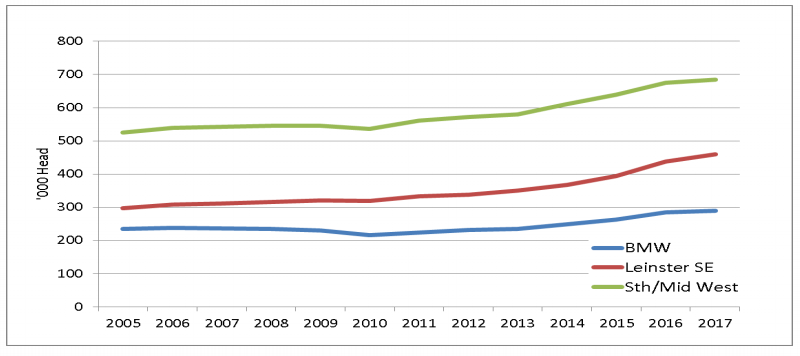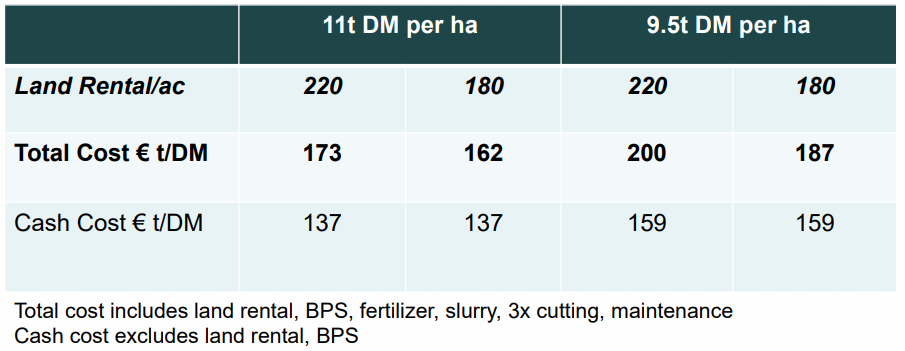Dairy farmers seeking to purchase forages should focus on the overall cost per tonne of dry matter, Teagasc’s Dr. Joe Patton told delegates at the recent National Crops Forum.
Patton – a Teagasc dairy specialist – was tasked with informing tillage farmers of the potential opportunities that may arise from an expanded Irish dairy herd.
“It really doesn’t make a huge amount of difference [what the forage is] as long as the value per tonne of dry matter is there. We need to make sure that’s the case when we talk about contracts and trading; it’s the €/t of dry matter [that matters] and people are very well versed in that at this stage,” he said.
When it comes to the additional 400,000-odd dairy cows found on Irish dairy farms over recent years, Patton said: “The real action has been in Leinster, the south and the mid-west.
“But Leinster and the south-east area is quite interesting because there’s been a big increase in cow numbers in that region.
There’s a 55% increase in cow numbers in that region, which accounts for 43% or almost half of the total cow numbers overall.
“In your traditional tillage area, you’re seeing a huge jump and obviously in the Munster region there’s about another 160,000 cows there as well,” he said.
Despite this increase, Patton said that improvements at farm level – when it comes to growing more grass and matching stocking rate to demand – will limit the market available somewhat to tillage farmers willing to supply forages to livestock farmers.
The pattern of dairy expansion, he noted, has been pretty much fixated on spring-calving systems and this will have an impact on the quality of forage required.
They are competing for something the equivalent of 70 DMD (dry matter digestibility) grass silage. We are not looking for rocket fuel here.
“We are not looking for absolutely premium quality in terms of energy and protein per kilogram of dry matter. We’re probably looking at something that is valued as winter forage.
“Maybe 30-40% of that will be as a complement to grazed grass in the shoulders of the year, but there’s not going to be a huge market for additional feed for milking cows over the winter period.
“The idea that it’s going to be a 50% maize diet fed to high-yielding cows over the winter, there’s not going to be a market in that.”
Feed requirements
Touching on feed requirements, Joe said: “The most profitable farmers are growing up to 15t/ha of dry matter and are stocked up to 3.1 on the grazing platform. They are probably stocked at 2.6 overall.
“There’s a deficit of about 2t/ha on the grazing area, which comes to about 600-800kg/cow. At the moment, that’s predominately sourced from external land, where silage is sourced from an out block.”
However, an opportunity may exist for tillage farmers to access some of this market where they are able to better the costs associated with growing grass silage on conacre land.
“Your standard 100-cow herd is going to be short 60t of dry matter, which is 300t of silage and that’s the scale of the market you are looking at.”
At a conacre rental cost of €220/ac, Patton said tillage farmers need to be in a position to provide a forage at the equivalent cost of €170-200/t of dry matter to compete with grass silage grown on conacre ground.
“Can you beat that?”
When it comes to the options available, he said: “Dairy and beef farmers like feeding maize and wholecrop, but they hate growing them.
“When dairy farmers talk about maize and wholecrop, they just want it in the yard. They don’t want to know what variety it is or when it was sown. They just want it in the yard.”
He continued: “Both these crops are excellent as buffer crops to feed along with grass in the shoulders. Maize has taken a hammering over a few years in terms of the cost per tonne and that’s probably down to people growing it in inappropriate sites and inappropriate situations.
“Dairy farmers and livestock farmers, by and large, have turned their back on it a little bit. It’s a specialised crop. If maize can be grown at the right money, it’s probably the crop people will jump to first,” he said.
Patton also highlighted the importance on contracts when it comes to tillage farmers agreeing to grow crops for livestock farmers.



